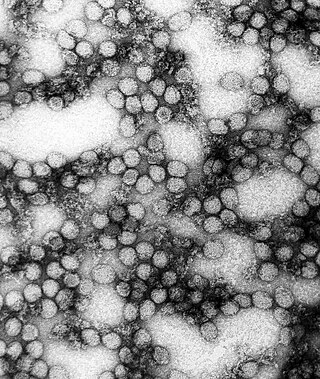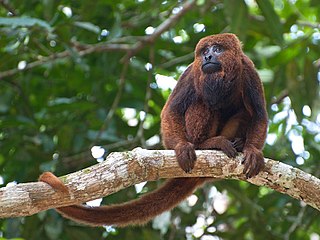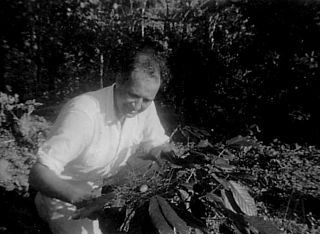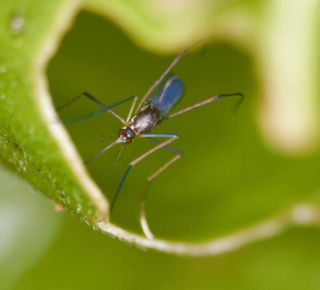
Yellow fever is a viral disease of typically short duration. In most cases, symptoms include fever, chills, loss of appetite, nausea, muscle pains—particularly in the back—and headaches. Symptoms typically improve within five days. In about 15% of people, within a day of improving the fever comes back, abdominal pain occurs, and liver damage begins causing yellow skin. If this occurs, the risk of bleeding and kidney problems is increased.

Arbovirus is an informal name for any virus that is transmitted by arthropod vectors. The term arbovirus is a portmanteau word. Tibovirus is sometimes used to more specifically describe viruses transmitted by ticks, a superorder within the arthropods. Arboviruses can affect both animals and plants. In humans, symptoms of arbovirus infection generally occur 3–15 days after exposure to the virus and last three or four days. The most common clinical features of infection are fever, headache, and malaise, but encephalitis and viral hemorrhagic fever may also occur.

Max Theiler was a South African-American virologist and physician. He was awarded the Nobel Prize in Physiology or Medicine in 1951 for developing a vaccine against yellow fever in 1937, becoming the first African-born Nobel laureate.

Oropouche fever is a tropical viral infection transmitted by biting midges and mosquitoes from the blood of sloths to humans. This disease is named after the region where it was first discovered and isolated at the Trinidad Regional Virus Laboratory in 1955 by the Oropouche River in Trinidad and Tobago. Oropouche fever is caused by a specific arbovirus, the Oropouche virus (OROV), of the Bunyaviridae family.

The brown howler, also known as brown howler monkey, is a species of howler monkey, a type of New World monkey that lives in forests in south-eastern Brazil and far north-eastern Argentina (Misiones). It lives in groups of two to 11 individuals. Despite the name "brown howler", it is notably variable in colour, with some individuals appearing largely reddish-orange or black.

Phlebovirus is one of twenty genera of the family Phenuiviridae in the order Bunyavirales. The genus contains 66 species. It derives its name from Phlebotominae, the vectors of member species Naples phlebovirus, which is said to be ultimately from the Greek phlebos, meaning "vein". The proper word for "vein" in ancient Greek is however phleps (φλέψ).

Wilbur George Downs, was a naturalist, virologist and clinical professor of epidemiology and public health at the Yale School of Medicine and the Yale School of Public Health.

The Trinidad Regional Virus Laboratory (T.R.V.L.) was established in Port of Spain, in 1953 by the Rockefeller Foundation in co-operation with the Government of Trinidad and Tobago. It was originally housed in an old wooden army barracks near the docks in Port of Spain. A large wired-in "animal house" was built out back to house the many wild animals brought in for study.
Ochlerotatus is a genus of mosquito. Until 2000, it was ranked as a subgenus of Aedes, but after Reinert's work, the clade was upgraded to the level of a genus. This change has resulted in the renaming of many subgenus species, and many aedini-related taxa are undergoing taxonomic revisions. Some authors are still using traditional taxonomic names in their publications.

Yellow fever vaccine is a vaccine that protects against yellow fever. Yellow fever is a viral infection that occurs in Africa and South America. Most people begin to develop immunity within ten days of vaccination and 99% are protected within one month, and this appears to be lifelong. The vaccine can be used to control outbreaks of disease. It is given either by injection into a muscle or just under the skin.

Anopheles is a genus of mosquitoes (Culicidae) with about 484 recognised species.
Pylore Krishnaier Rajagopalan was an Indian vector control scientist, biologist and acarologist, known for his pioneering contributions to the control programmes against vector-borne diseases in India. He was a former director of the Indian Council of Medical Research managed Vector Control Research Centre, Pondicherry. He graduated in 1949 from the Banaras Hindu University and obtained a Masters in Zoology with University First Rank there itself in 1951. In 1952 he joined the fledgling Virus Research Centre in Pune, and worked under the supervision of some of the finest vector control specialists such as Dr T Ramachandra Rao. In recognition of his outstanding work as a young research scientist, in 1957 he was awarded a Fellowship by the Rockefeller Foundation to pursue a Master's program in Public Health from the University of California. He went on to secure a Diploma in Acarology from the University of Maryland at College Park.
Spondweni virus is an arbovirus, or arthropod-borne virus, which is a member of the family Flaviviridae and the genus Flavivirus. It is part of the Spondweni serogroup which consists of the Sponweni virus and the Zika virus (ZIKV). The Spondweni virus was first isolated in Nigeria in 1952, and ever since, SPONV transmission and activity have been reported throughout Africa. Its primary vector of transmission is the sylvatic mosquito Aedes circumluteolus, though it has been isolated from several different types of mosquito. Transmission of the virus into humans can lead to a viral infection known as Spondweni fever, with symptoms ranging from headache and nausea to myalgia and arthralgia. However, as SPONV is phylogenetically close to the ZIKV, it is commonly misdiagnosed as ZIKV along with other viral illnesses.

Robert Ellis Shope was an American virologist, epidemiologist and public health expert, particularly known for his work on arthropod-borne viruses and emerging infectious diseases. He discovered more novel viruses than any person previously, including members of the Arenavirus, Hantavirus, Lyssavirus and Orbivirus genera of RNA viruses. He researched significant human diseases, including dengue, Lassa fever, Rift Valley fever, yellow fever, viral hemorrhagic fevers and Lyme disease. He had an encyclopedic knowledge of viruses, and curated a global reference collection of over 5,000 viral strains. He was the lead author of a groundbreaking report on the threat posed by emerging infectious diseases, and also advised on climate change and bioterrorism.
Haemogogus clarki is an arboreal mosquito native to southern Central America and northern South America. It is deep brown in color with conspicuous patterns of silver scales on the scutum and pleuron. The specific epithet honors Dr. Herbert C. Clark, former Director of the Gorgas Memorial Laboratory.

Sabethes or canopy mosquitos are primarily an arboreal genus, breeding in plant cavities. The type species is Sabethes locuples, first described by Jean-Baptiste Robineau-Desvoidy in 1827.

Wyeomyia is a genus of mosquitoes first described in 1901 by Frederick Vincent Theobald. The genus's 140 species can be difficult to characterize because of their diversity and the need for additional taxonomic work to further delineate them. Adults resemble genus Limatus and Sabethes mosquitoes more closely than other genera in the New World tribe Sabethini, but differ by their scutal scales ranging in color from a relatively dull bronzy with a slight metallic sheen in most species, to a metallic gold. There are other distinguishing characters as well.












